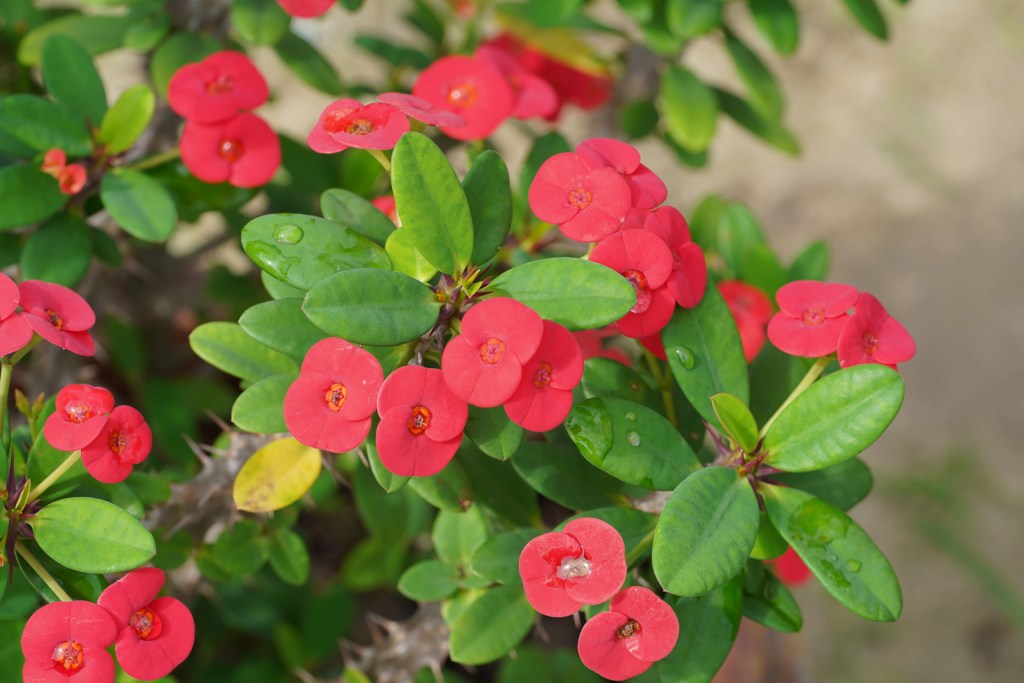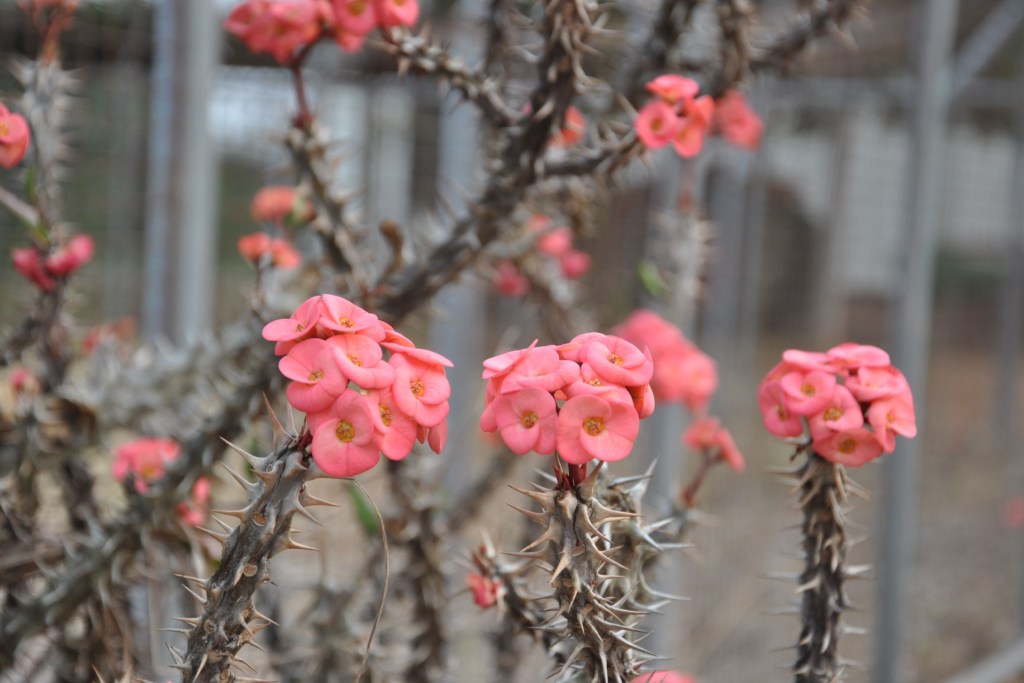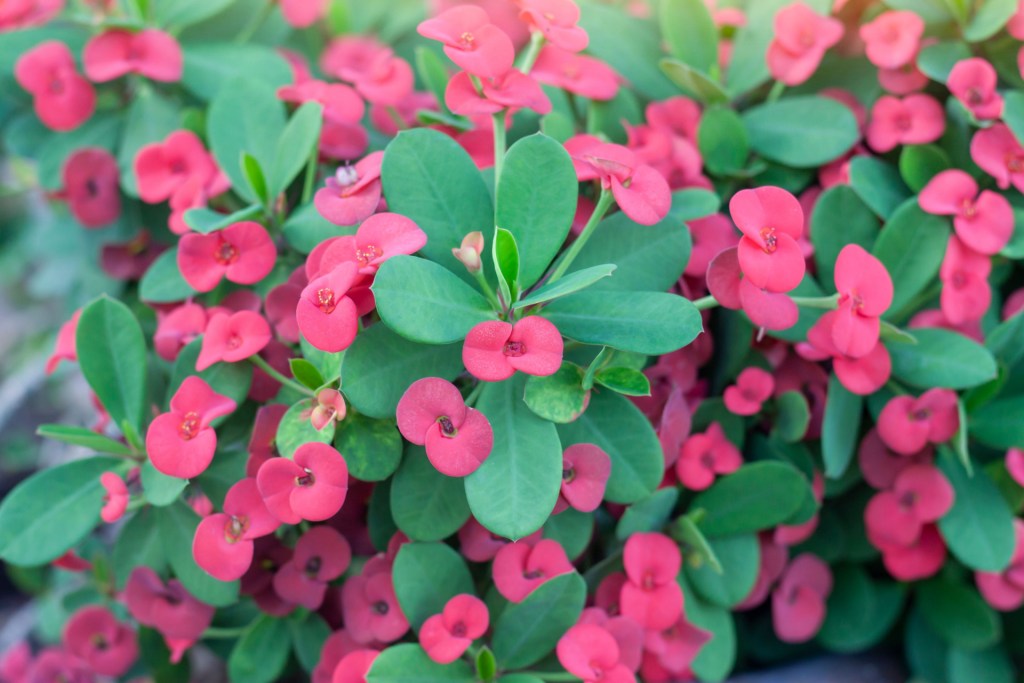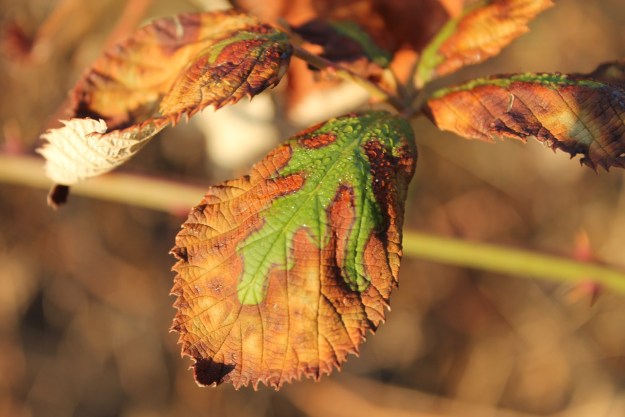Every rose has its thorn, but with a crown of thorns plant, it's all thorns and a few bold, lush bracts surrounding tiny flowers. Though intimidating in looks, the crown of thorns plant is beloved for its low-key care requirements. And although it flowers, it's actually pretty easy to care for indoors. From finding the just-right growing medium to propagating stem tips, here's everything you need to know about this striking houseplant.

Why is it called a crown of thorns plant?
Scientifically referred to as Euphorbia milii, the crown of thorns gets its colloquial name from biblical lore. As the story goes, Jesus wore this at his crucifixion as a crown, the red bracts representing his blood. Native to Madagascar, a crown of thorns plant features small leaves and tiny flowers with showy bracts on woody stems with long spines. The bracts are typically red, but you may find light pink, orange, white, and yellow blooms, as well. In optimal conditions, the plant can grow up to 3 feet tall and 4 feet wide.
As you might have already guessed from the barbed stems, this plant is toxic and can irritate the skin, so you should handle it with caution. If you need to repot it, it's best to wear thick leather gloves and wrap it around layers of newspaper when dealing with it. Additionally, keep an eye out for curious pets and children who might play around it.

How do you care for a crown of thorns plant?
Because of its succulent nature, the crown of thorns plant is pretty easy to care for. While it's technically only hardy in climate zones 9 to 11, it can be overwintered in virtually any home that gets sufficient sunlight. Luckily, its care requirements indoors are quite simple. Don't fret if you notice little growth — crown of thorns are slow growers and only need to be repotted every three years.
Step 1: Growing medium
Keep your crown of thorns in a well-draining potting mix that's sandy. For extra drainage, you can also mix sand into your potting mix. If you must move your plant, remember to use thick leather gardening gloves and roll the plant in newspaper to keep it from poking you.
Step 2: Lighting
Place your plant next to a bright window that receives southern exposure. Crown of thorns can be very happy indoors, but it does thrive outside. During the hottest days of summer, move your plant to an area where it can receive afternoon shade.
Step 3: Temperature
Leave your crown of thorns in an area where it gets no colder than 55 degrees Fahrenheit — room temperature around the 60s or 70s is a sweet spot for this plant. When the temperatures dip into the 50s, you may notice falling leaves.
Step 4: Watering
Water your plant when the top inch of soil feels dry to the touch. Crown of thorns doesn't like to dry out completely, but they can tolerate some neglect.
Step 5: Fertilizing
From spring to early fall, fertilize your crown of thorns with a balanced liquid fertilizer at half strength every two weeks.

How do you get a crown of thorns plant to bloom?
As a rule of thumb, crown of thorns blooms from early spring to the middle of summer. However, you can get your plant to bloom all year long if you give it adequate lighting. In fact, a crown of thorns kept as a houseplant might be more likely to bloom after the traditional growing season.
Keep in mind that the flowers themselves are tiny, and it's the bracts (the modified leaves positioned beneath flowers) that are colorful — just like the poinsettia flowers you see during the holidays (which are also euphorbias).
Step 1: Place your plant by a window with southern exposure to give it the most amount of direct sunlight it can possibly receive — at least 3 to 4 hours of bright light per day is ideal.
Light will give your plant the energy it needs to bloom. You might also consider supplementing natural light with grow lights or bringing your plant outdoors if the temperature is warm enough.
Step 2: Keep your crown of thorns as healthy as possible by watering it consistently and leaving it in warm temperatures.
When your plant is stressed, it will be less likely to bloom.
Step 3: Fertilize your plant at a biweekly cadence — overfertilizing can actually lead to more foliage and less blooms.

How do you propagate a crown of thorns?
Propagating your crown of thorns plant from seed is possible but a time-consuming task. You'd essentially need to pollinate your plant by hand to get it to produce seeds, wait for seed capsules to form, and then germinate those seeds. The easiest way to propagate a crown of thorns plant is by carefully taking stem tip cuttings — with a big emphasis on the carefully!
Step 1: With gloves on, cut off a growing tip 3 to 4 inches down the stem with sterilized pruning shears.
Step 2: Allow the milky sap to dry out and let the plant form a callus for about a day.
Step 3: Place your cutting in a lightly moist peat moss and sand mix, keeping it in an area that gets bright indirect light.
Step 4: Transfer your plant into a regular potting mix once you see roots form in about one to two months.
The crown of thorns plant might be tough in looks, but it's actually quite easy in care. Able to tolerate neglect, its main requirements are bright light and well-draining soil. From there, you'll be able to foster slow but consistent growth. Just remember to handle it with caution!
Editors' Recommendations
- How often do bromeliads flower? How to help these blooms thrive
- How long does it take for a cactus to grow? Here’s what we know
- Now that it’s more common, here’s how to care for your sought-after Thai Constellation Monstera
- Can you grow plants in water beads? Here’s what you need to know
- Can pothos live in water forever? How to root, grow, and propagate pothos in water




